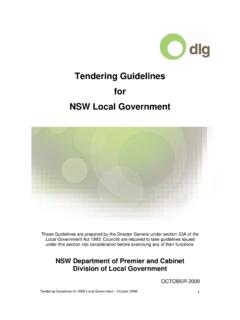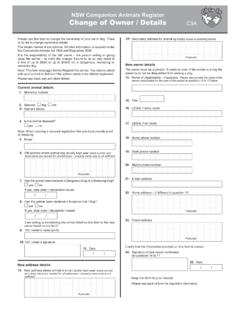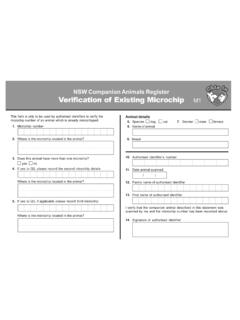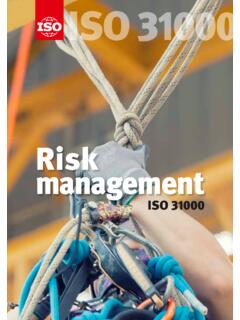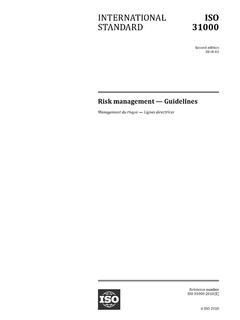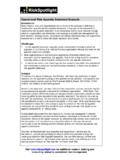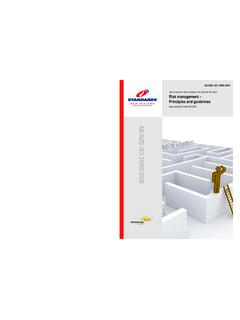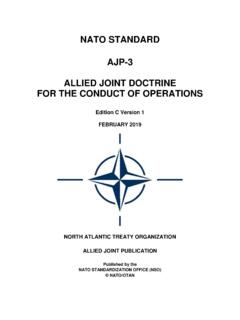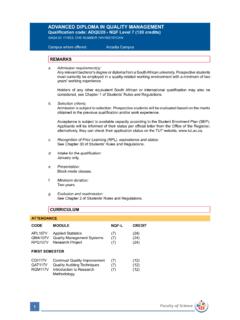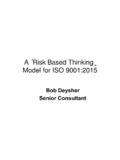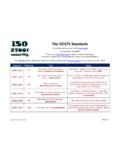Transcription of RISK MANAGEMENT AND INTERNAL AUDIT for local …
1 Guidelines for Risk MANAGEMENT and INTERNAL AUDIT for local Government in NSW 1 RISK MANAGEMENT AND INTERNAL AUDIT for local councils in NSW Guidelines August 2021 Guidelines for Risk MANAGEMENT and INTERNAL AUDIT for local Government in NSW 2 GUIDELINES FOR RISK MANAGEMENT AND INTERNAL AUDIT FOR local COUNCILS IN NSW 2021 ACCESS TO SERVICES The Office of local Government is located at: Street Address: Levels 1 & 2, 5 O Keefe Avenue, NOWRA NSW 2541 Postal Address: Locked Bag 3015, Nowra, NSW 2541 Phone: 02 4428 4100 Fax: 02 4428 4199 TTY: 02 4428 4209 Email : Website: OFFICE HOURS Monday to Friday to (Special arrangements may be made if these hours are unsuitable) All offices are wheelchair accessible. ALTERNATIVE MEDIA PUBLICATIONS Special arrangements can be made for our publications to be provided in large print or an alternative media format.
2 If you need this service, please contact Client Services on 02 4428 4100. DISCLAIMER While every effort has been made to ensure the accuracy of the information in this publication, the Office of local Government expressly disclaims any liability to any person in respect of anything done or not done as a result of the contents of the publication or the data provided. NSW Office of local Government, Department of Planning, Industry and Environment 2021 Produced by the NSW Office of local Government, Department of Planning, Industry and Environment Guidelines for Risk MANAGEMENT and INTERNAL AUDIT for local Government in NSW 3 Contents Background 5 Purpose 6 Statutory framework 8 Annual attestation 100 Monitoring 11 Core requirement 1: AUDIT , risk and improvement committees 12 Guiding principles for AUDIT , risk and improvement committees 13 Role and functions 13 Workplans 13 Providing advice to the governing body 155 Terms of Reference 18 Structure 18 Size and composition 19 Shared committees 22 Independence requirements 23 Eligibility requirements 23 Appointment 25 Membership terms 26 Fees 27 Roles of committee members 28 Key relationships 29 Meetings 30 Confidentiality 33 Secretariat 33 Access to council, staff, resources and information 33 Disputes 344 Conduct 344 Insurance 35 Learning and development 35 Review of committee performance 36 Annual attestation 37 Resignation of committee members 377 Dismissal of committee members 38 Further resources 39 Core requirement 2.
3 Risk MANAGEMENT 41 Guiding principles for risk MANAGEMENT 42 standards 42 County councils and joint organisations 44 Resourcing 45 Guidelines for Risk MANAGEMENT and INTERNAL AUDIT for local Government in NSW 4 Roles and responsibilities 45 Review and reporting 48 Annual attestation 49 Further resources 50 Core requirement 3: INTERNAL AUDIT function 51 Guiding principles for INTERNAL AUDIT 52 Independence 522 Resourcing 52 INTERNAL AUDIT Charter 53 Role of the general manager 53 Role of the AUDIT , risk and improvement committee 54 Structure 54 In-house INTERNAL AUDIT function 55 Outsourced INTERNAL AUDIT function 58 Shared INTERNAL AUDIT function 60 Workplans 62 Performing INTERNAL audits 62 Providing advice to the AUDIT , risk and improvement committee 644 INTERNAL AUDIT documents 64 Review of INTERNAL AUDIT function performance 65 Reporting concerns about councillors or council staff 66 Annual attestation 66 Further resources 68 Implementation 69 AUDIT , risk and improvement committees 70 Risk MANAGEMENT framework 70 INTERNAL AUDIT function 700 Attestation 700 Appendix 1: Attestation template and Determination template 711 Appendix 2.
4 AUDIT , risk and improvement committee role and responsibilities 766 Appendix 3: Model Terms of Reference for AUDIT , risk and improvement committees 822 Appendix 4: Council categories 95 Appendix 5: Example risk MANAGEMENT policy 99 Appendix 6: Model INTERNAL AUDIT Charter 1022 Guidelines for Risk MANAGEMENT and INTERNAL AUDIT for local Government in NSW 5 Background Guidelines for Risk MANAGEMENT and INTERNAL AUDIT for local Government in NSW 6 Background The local Government Act 1993 ( local Government Act ) and the local Government (General) Regulation 2005 ( local Government Regulation ) require each council in NSW to have: an AUDIT , risk and improvement committee that continuously reviews and provides independent advice to the council on how it is functioning and managing risk a robust risk MANAGEMENT framework that accurately identifies and mitigates the risks facing the council and its operations, and an effective INTERNAL AUDIT function that provides independent advice as to whether the council is functioning effectively and the council s INTERNAL controls to manage risk are working.
5 These three mandatory governance mechanisms are a vital part of the NSW Government s plan to ensure that councils are doing things the best way they can for their communities and are on track to delivering their community s goals and objectives. Communities themselves will ultimately be the greatest beneficiaries. If implemented effectively, AUDIT , risk and improvement committees, risk MANAGEMENT and INTERNAL AUDIT will lead to councils: achieving their strategic objectives in the most efficient, effective and economical manner having better and more efficient levels of service delivery having increased accountability and transparency achieving better decision-making and having the confidence to make difficult decisions having increased financial stability achieving and maintaining compliance with all laws, regulations, INTERNAL policies and procedures, and better safeguarding their public assets.
6 Purpose These guidelines have been developed to assist councils, county councils and joint organisations to comply with statutory requirements under the local Government Act and local Government Regulation. They also seek to strengthen risk MANAGEMENT and INTERNAL AUDIT practices in NSW councils by setting a minimum standard that reflects a best practice approach. The Guidelines have been issued under the local Government Regulation (clause #tbc) which confers on the Secretary of the Department of Planning, Industry and Environment, ( Secretary DPIE ), the power to issue guidelines on the appointment and operation of AUDIT , risk and improvement committees and the implementation by councils, county councils and joint organisations of risk MANAGEMENT and INTERNAL AUDIT activities. Councils are required under the local Government Regulation to comply with these Guidelines when establishing and operating their AUDIT , risk and improvement committees, risk MANAGEMENT framework and INTERNAL AUDIT functions.
7 They replace the NSW Government s INTERNAL AUDIT Guidelines for local Government in NSW issued in 2010. The three core requirements outlined in the Guidelines reflect international standards and the recommendations and opinions of INTERNAL AUDIT practitioners, councils, councillors, AUDIT , risk and improvement committee members, risk MANAGEMENT practitioners, government agencies, experts and community members. They are also informed by practices in other Australian jurisdictions and give effect to the recommendations of the: Independent Commission Against Corruption in its inquiries into Burwood Council (2011) and Botany Bay Council (2017) Guidelines for Risk MANAGEMENT and INTERNAL AUDIT for local Government in NSW 7 local Government Acts Taskforce in its review of the local Government Act 1993 (2013) Independent local Government Review Panel in its Revitalising local Government inquiry (2013), and various performance audits and other reviews conducted by the NSW Auditor-General since 2010.
8 Based on these recommendations: the core requirements outlined in the Guidelines relating to the operation of a council s AUDIT , risk and improvement committee have been modelled on the INTERNAL AUDIT and Risk MANAGEMENT Policy for the General Government Sector (TPP 20-08) developed by NSW Treasury and best practice in the public and private sectors the core requirements relating to risk MANAGEMENT have been modelled on the current Australian risk MANAGEMENT standard, AS/NZS ISO 31000 :2018 Risk MANAGEMENT Guidelines, and the core requirements relating to a council s INTERNAL AUDIT function have been modelled on the Institute of INTERNAL Auditors (IIA) International standards for the Professional Practice of INTERNAL Auditing (the International Professional Practices Framework ) and best practice in the public and private sectors. The framework balances these professional standards and best practice approaches with the unique structure, needs and operating environments of metropolitan, regional and rural councils, county councils and joint organisations across NSW.
9 The release of these Guidelines follows an extensive consultation process. The Office of local Government thanks all the individuals, councils and bodies involved in the development of the risk MANAGEMENT and INTERNAL AUDIT regulatory framework. Further resources There has been a wide range of information and guidance developed in recent times by government agencies, experts, practitioners and other bodies to help organisations establish effective AUDIT , risk and improvement committees, risk MANAGEMENT frameworks and INTERNAL AUDIT functions. As a starting point, a list of further resources has been included at the end of each core requirement. These resources provide practical information and tools such as examples, templates, checklists and sample documents that councils may find useful when implementing these Guidelines. Terminology When a joint organisation is applying these Guidelines, it should substitute the term council for joint organisation , governing body for board , chairperson for mayor.
10 Voting representative for councillor and executive officer for general manager and annual report for annual performance statement , where appropriate. Where a county council is applying these guidelines, it should substitute the terms county council for council and member for councillor , where appropriate. Guidelines for Risk MANAGEMENT and INTERNAL AUDIT for local Government in NSW 8 Statutory framework The local Government Act and local Government Regulation provide the statutory foundations and prescribe the desired outcomes for councils AUDIT , risk and improvement committees, risk MANAGEMENT frameworks and INTERNAL AUDIT functions. Relevant provisions of the local Government Act and local Government Regulation are detailed below. Guiding principles of local government The guiding principles of the local Government Act (sections 8A, 8B and 8C) require each council to carry out its functions in a way that provides the best possible value for residents and ratepayers.



